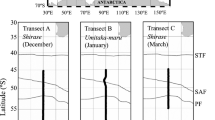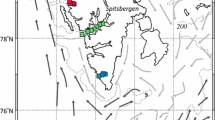Abstract
Mesozooplankton community structure in the vicinity of the Prince Edward Islands (PEIs) was investigated during six surveys conducted in late austral summer (April/May) from 1996 to 1999. Zooplankton samples were collected by oblique tows using a Bongo net fitted with 300-μm mesh. Surface temperature, average temperature and chlorophyll a were measured in conjunction with each net tow. The positions of the Sub-Antarctic Front (SAF) and the Antarctic Polar Front (APF), in relation to the islands, were determined by CTD and/or XBT transects to the west of the islands (upstream). Both fronts were characterized by a high degree of latitudinal variation. Changes in position of the fronts occurred rapidly, the SAF moving up to ∼120 km in a 2-week period. Consequently, the oceanographic environment in the vicinity of the PEIs was subject to a high degree of intra- and inter-survey variation. The positions of the SAF and APF appeared to have a significant impact on phytoplankton biomass in the vicinity of the PEIs, possibly through the alteration of local oceanographic flow dynamics. Water retention over the island shelf in 1996, associated with location of the SAF far to the north of the PEIs, corresponded to enhanced chlorophyll-a concentrations (∼1.54 mg m−3). Conversely, when the fronts were close to the islands, as in 1997 and 1999, higher current velocity limited water retention and chlorophyll-a concentrations in the inter-island region were relatively low (∼0.4 mg m−3). Cluster analyses showed that, in many instances, there was greater similarity among zooplankton communities from different surveys than among communities within surveys, indicating that short-term variability exceeded inter-annual variability. The population structure of the copepod Calanus simillimus indicated that there was inter-annual variation in the timing of the biological season. Differences in the population structure of species, and consequently their contribution to abundance and biomass, may therefore have been an important contributor to inter-annual variation in community structure. Evidence is provided of a long-term southward shift in the position of the SAF. It is postulated that this may affect the PEIs by increasing the proportion of allochthonous energy input, because the PEIs now lie in the path of the front, altering the tropho-dynamics of the island ecosystem. Lower mesozooplankton biomass associated with warmer sub-Antarctic water may have important negative consequences for higher trophic levels that depend on mesozooplankton for food.
Similar content being viewed by others
Author information
Authors and Affiliations
Additional information
Received: 10 June 2000 / Accepted: 22 September 2000
Rights and permissions
About this article
Cite this article
Hunt, B., Pakhomov, E. & McQuaid, C. Short-term variation and long-term changes in the oceanographic environment and zooplankton community in the vicinity of a sub-Antarctic archipelago. Marine Biology 138, 369–381 (2001). https://doi.org/10.1007/s002270000467
Issue Date:
DOI: https://doi.org/10.1007/s002270000467




